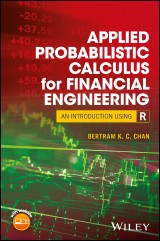Details

Applied Probabilistic Calculus for Financial Engineering
An Introduction Using R1. Aufl.
|
118,99 € |
|
| Verlag: | Wiley |
| Format: | |
| Veröffentl.: | 11.09.2017 |
| ISBN/EAN: | 9781119388081 |
| Sprache: | englisch |
| Anzahl Seiten: | 536 |
DRM-geschütztes eBook, Sie benötigen z.B. Adobe Digital Editions und eine Adobe ID zum Lesen.
Beschreibungen
<p><b>Illustrates how R may be used successfully to solve problems in quantitative finance</b></p> <p><i>Applied Probabilistic Calculus for Financial Engineering: An Introduction Using R</i> provides R recipes for asset allocation and portfolio optimization problems. It begins by introducing all the necessary probabilistic and statistical foundations, before moving on to topics related to asset allocation and portfolio optimization with R codes illustrated for various examples. This clear and concise book covers financial engineering, using R in data analysis, and univariate, bivariate, and multivariate data analysis. It examines probabilistic calculus for modeling financial engineering—walking the reader through building an effective financial model from the Geometric Brownian Motion (GBM) Model via probabilistic calculus, while also covering Ito Calculus. Classical mathematical models in financial engineering and modern portfolio theory are discussed—along with the Two Mutual Fund Theorem and The Sharpe Ratio. The book also looks at R as a calculator and using R in data analysis in financial engineering. Additionally, it covers asset allocation using R, financial risk modeling and portfolio optimization using R, global and local optimal values, locating functional maxima and minima, and portfolio optimization by performance analytics in CRAN.</p> <ul> <li>Covers optimization methodologies in probabilistic calculus for financial engineering</li> <li>Answers the question: What does a "Random Walk" Financial Theory look like?</li> <li>Covers the GBM Model and the Random Walk Model</li> <li>Examines modern theories of portfolio optimization, including The Markowitz Model of Modern Portfolio Theory (MPT), The Black-Litterman Model, and The Black-Scholes Option Pricing Model</li> </ul> <p><i>Applied Probabilistic Calculus for Financial Engineering: An Introduction Using R</i> s an ideal reference for professionals and students in economics, econometrics, and finance, as well as for financial investment quants and financial engineers.</p>
<p>Preface</p> <p>Dedication</p> <p><b>Chapter 1: Introduction to Financial Engineering</b></p> <p>1 Introduction to Financial Engineering</p> <p>1.1 What is Financial Engineering?</p> <p>1.2 The Meaning of the Title of this Book</p> <p>1.3 The Continuing Challenge in Financial Engineering</p> <p>1.4 “Financial Engineering 101”: Modern Portfolio Theory[2]</p> <p>1.5 Asset Class Assumptions Modeling</p> <p>1.6 Typical Examples of Proprietary Investment Funds</p> <p>1.7 The Dow Jones Industrial Average (DJIA) and Inflation</p> <p>1.8 Some Less Commendable Stock Investment Approaches</p> <p>1.9 Developing Tools for Financial Engineering Analysis Solutions to Exercises in Chapter 1: </p> <p><b>Chapter 2: Probabilistic Calculus for Modeling Financial Engineering</b></p> <p>2.1 Introduction to Financial Engineering</p> <p>2.2 Mathematical Modeling in Financial Engineering</p> <p>2.3 Building an Effective Financial Model from GBM via Probabilistic Calculus</p> <p>2.4 A Continuous Financial Model Using Probabilistic Calculus (Stochastic Calculus, Ito Calculus)</p> <p>2.5 Numerical Examples of Representation of Financial Data Using R</p> <p><b>Chapter 3: Classical Mathematical Models in Financial Engineering and Modern Portfolio Theory</b></p> <p>3.0 An Introduction to the Cost of Money in the Financial Market</p> <p>3.1 Modern Theories of Portfolio Optimization</p> <p>3.2 The Black-Litterman Model</p> <p>3.3 The Black-Scholes Option Pricing Model</p> <p><b>Chapter 4: Data Analysis Using R Programming</b></p> <p>4.1 Data and Processing</p> <p>4.2 Beginning R</p> <p>4.3 R as a Calculator</p> <p>4.4 Using R in Data Analysis in Financial Engineering</p> <p>4.5 Univariate, Bivariate, and Multivariate Data Analysis</p> <p>Appendix 1: Documentation for the plot function</p> <p>Special References for Chapter 4</p> <p><b>Chapter 5: Assets Allocation Using R </b></p> <p>5.1 Risk Aversion and the Assets Allocation Process</p> <p>5.2 Classical Assets Allocation Approaches</p> <p>5.3 Allocation with Time Varying Risk Aversion</p> <p>5.4 Variable Risk Preference Bias</p> <p>5.5 A Unified Approach for Time Varying Risk Aversion</p> <p>5.6 Assets Allocation Worked Examples</p> <p><b>Chapter 6: Financial Risk Modeling and Portfolio Optimization Using R</b></p> <p>6.1 Introduction to the Optimization Process</p> <p>6.2 Optimization Methodologies in Probabilistic Calculus for Financial Engineering</p> <p>6.3 Financial Risk Modeling and Portfolio Optimization </p> <p>References</p> <p>Index</p>
<p><b> BERTRAM K. C. CHAN, PhD,</b> is Consulting Biostatistician at the Loma Linda University Health, School of Medicine, Loma Linda, CA. Dr. Chan is also Software Development and Forum Lecturer at the School of Public Health, LLUH Department of Biostatistics and Epidemiology.
<p><b> Illustrates how R may be used successfully to solve problems in quantitative finance </b> <p><i> Applied Probabilistic Calculus for Financial Engineering: An Introduction Using R</i> provides R recipes for asset allocation and portfolio optimization problems. It begins by introducing all the necessary probabilistic and statistical foundations, before moving on to topics related to asset allocation and portfolio optimization with R codes illustrated for various examples. <p> This clear and concise book covers financial engineering, using R in data analysis, and univariate, bivariate, and multivariate data analysis. It examines probabilistic calculus for modeling financial engineering—walking the reader through building an effective financial model from the Geometric Brownian Motion (GBM) Model via probabilistic calculus, while also covering Ito Calculus. Classical mathematical models in financial engineering and modern portfolio theory are discussed—along with the Two Mutual Fund Theorem and The Sharpe Ratio. The book also looks at R as a calculator and using R in data analysis in financial engineering. Additionally, it covers asset allocation using R, financial risk modeling and portfolio optimization using R, global and local optimal values, locating functional maxima and minima, and portfolio optimization by performance analytics in CRAN. <ul> <li>Covers optimization methodologies in probabilistic calculus for financial engineering</li> <li>Answers the question: What does a "Random Walk" Financial Theory look like?</li> <li>Covers the GBM Model and the Random Walk Model</li> <li>Examines modern theories of portfolio optimization, including The Markowitz Model of Modern Portfolio Theory (MPT), The Black-Litterman Model, and The Black-Scholes Option Pricing Model</li> </ul> <br> <p><i> Applied Probabilistic Calculus for Financial Engineering: An Introduction Using R</i> is an ideal reference for professionals and students in economics, econometrics, and finance, as well as for financial investment quants and financial engineers.

















